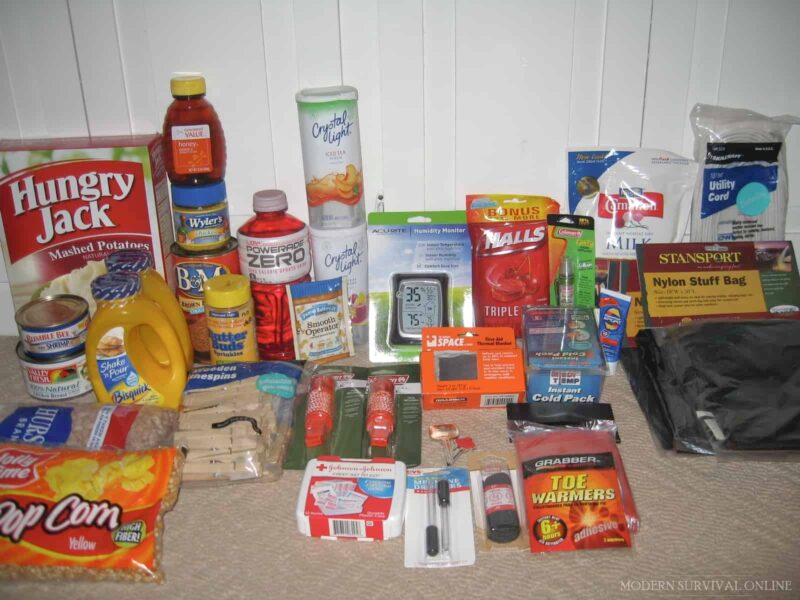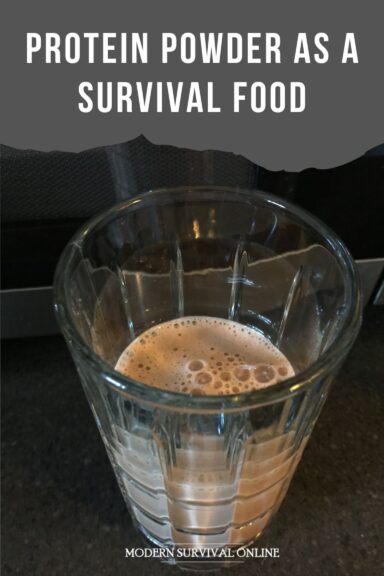Preppers who are getting ready for long-term survival scenarios and living in the aftermath of disasters are always looking for a better survival food option. Something that is more nutritionally complete, longer lasting, easier to prepare, easier to carry, etc.

Some folks have suggested using protein powder as a survival food, and I must admit this is not something that I myself had thought of before. But what’s the scoop? Is protein powder a good survival food or not?
Yes, protein powder is a pretty good survival food. It’s an easy and convenient way to carry plenty of easily digested protein and calories with you, and is versatile enough to be prepared and drunk as is or mixed in with other foods. It isn’t, though, nutritionally complete.
I must say, whoever first thought of this really had their thinking cap on. Protein powder is a remarkably good survival food, though not a truly complete one.
Nonetheless, it can definitely make your life easier when packing a bug-out bag or stocking a survival pantry. Keep reading and I’ll tell you why below…
Nutritional Info
This is the info that matters. How nutritious is protein powder, generally? All around, it is pretty doggone good, though of course, there’s a huge amount of variation among all the products on the market, and there are many!
But, as a base guideline, you can depend on a 30 g serving of naturally sweetened whey protein powder, which is about one scoop, to provide 120 kcal, anywhere from 20 to 24g of protein, and 3 to 8 g of carbohydrates along with a little bit of fat.
Most powders also have a bit of sodium and lots of vitamins and minerals, especially B vitamins, though some are significantly better fortified than others. In any case, you can count on getting lots of calcium, a decent amount of iron, plenty of potassium, and more.
One thing I’d like you to keep in mind is that many such products are made for folks who are working out and trying to stay fit, and accordingly, they try to keep calories at a minimum. This is usually accomplished through the use of artificial sweeteners.
Think twice before getting one of those products because in a survival situation every calorie counts, and so you’re usually better off going with something sweetened with sugar, honey, maple syrup, or something like that.
Protein Powder Lasts a Long Time in Storage
Aside from good nutrition, the other great thing that protein powder has going for it as a survival food is a very long shelf life. And it’s quite easy to store.
Again, another baseline for the shelf life of protein powder is about 5 years, conservatively, kept at room temp of about 70° F. Do that and you won’t have any issues. A little cooler or warmer isn’t a big deal, but high temps will degrade your powder!
Now, if you care to check the sell-by date on the jug you’ll see that most of them have a date that is about a year, maybe two, from the date of purchase.
Don’t let that misguide you: these dates are arbitrarily set by the manufacturer according to government guidelines and do not accurately reflect the actual shelf life of a product.
Think of them as a best-by or freshness date. Kept in a cool, dark location in a sealed container, protein powder will last a lot longer than that and be completely safe.
Keep Moisture Away and You’re Good to Go
The single most important thing you must do if you want your protein powder to go the distance in a survival situation is to keep it safe from moisture. I hope that would be obvious! We mix it with water or some other liquid to prepare it for consumption, after all.
If protein powder, of any kind, even gets damp, it will soon mold – that’s just going to ruin it.
Consider taking it out of the container, assuming it doesn’t have the factory seal still intact, and pack it in some sort of other heavy-duty packaging.
I like using vacuum-sealed Mylar bags, but you can also make a great case for keeping them in Ziploc freezer bags or smaller versions in pre-measured portions and then placing those inside a Nalgene bottle, storm bag or small Pelican case. That way, even if your pack gets doused, your protein powder will be fine.
Protein Powder is a Lot Easier to Carry on a Per-Calorie Basis
Now, some seasoned preppers might be balking already at the idea of protein powder as a survival food. After all, we have other mainstays like beef jerky, canned tuna, canned chicken, and so forth.
This is undeniably true, however, I assert that protein powder is far easier to carry in terms of weight per calorie and per gram of protein and also in terms of form factor than any of these canned goods, and it even beats out the foil-pouched versions of the same.
Compared to heavy, bulky, and inefficient canned goods, it wins by a mile and it’s still a logistical advantage compared to the other more modern kinds of packaging.
At home in the pantry, it might not make much difference. But in your BOB on your back while you’re hoofing it for your life across unforgiving terrain- I promise that’s an advantage you don’t want to give up.
Use Protein Powder to Fortify Other Food and Beverages
One of my favorite things about this stuff as a survival food is that it is so doggone versatile. If I’m in a hurry and just need to gas up quickly, I can pour a little powder into a cup or bottle, mix it with water, and then chug it down. Done.
But I can also mix it in with other foods like soups and stews, eggs, and more. This is a great way to add bulk, protein, and calories for basically no additional effort.
And before you ask, no, it doesn’t mean you’ll be getting a strawberries and cream omelet; you can get unflavored protein powder which is perfect for the job.
It Also Has Special Utility for the Sick and Injured
One factor that I think, regrettably, many preppers overlook in this discussion is the suitability of liquid nourishment for people who are sick and badly injured.
For those of us who have been there, it’s surprising how difficult, or even impossible, it can be to keep solid food down. When your body is in a crisis and shunting resources away from your stomach, you simply might not be able to process the nutrition that you desperately need.
Protein powder drinks or shakes, though not perfect, are usually a much better bet under the circumstances. This is something you should not discount if you want to be truly ready for all contingencies.
Protein Powder is Great for Making “Comfort” Dessert Beverages
Sort of in the same vein, your sweeter and more flavorful protein powders, stuff like classic fruit, dessert, and milkshake flavors, even more exotic stuff like key lime pie or cereal flavors, can be a great comfort food for adults and kids alike.
I don’t know when the last time you might have tried this stuff is, but most of the modern brands we have today are shockingly good!
Most preppers, myself included, tend to approach packing calories and liquids with a ruthless eye for efficiency, sparing not even a thought for human factors like “want,” “comfort,” “flavor,” and so forth.
Using protein powder, it’s possible to bring along something that will keep you going but also help you feel good under what might be the worst circumstances of your entire life.
Don’t underestimate the value of keeping yourself or someone else mentally in the game by fostering feel-good emotions when you can.
You’ll Need Water, Duh
Another update from Captain Obvious, I know, but don’t forget that at its most basic you’ll need extra water to prepare your protein powder, assuming you aren’t mixing it into food.
No kidding, right, right. But this means that you’ll either have to carry more water with you or be prepared to source water from somewhere in the environment.
I know every prepper’s already familiar with this notion and prepared to do so, but it also bears repeating here because you can’t count on mixing your protein powder with milk, juice, or something else that might make it taste better.
If you’re used to having a delicious protein powder shake after your workout made with whole-fat milk, the same stuff mixed with water might be a rude awakening.
Make sure you try and get comfortable with your chosen protein powder or powders made with water only ahead of time so you know what to expect.

The post Protein Powder as a Survival Food: Is it Any Good? appeared first on Modern Survival Online.
via Modern Survival Online https://ift.tt/HKzarMS
No comments:
Post a Comment